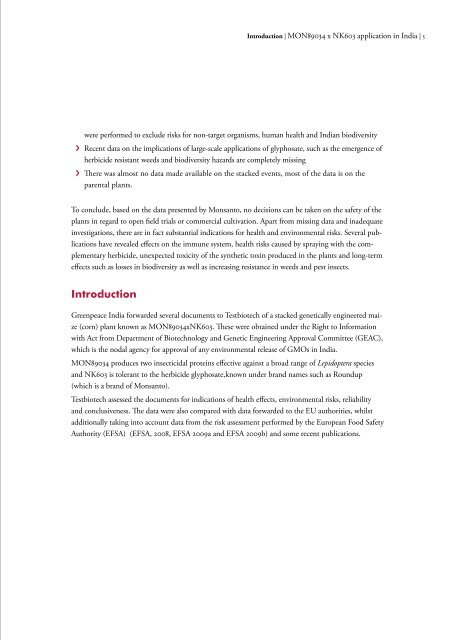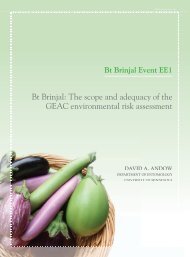publications complementary maize
TESTBIOTECH MON89034_x_NK603_application_India.pdf
TESTBIOTECH MON89034_x_NK603_application_India.pdf
- No tags were found...
Create successful ePaper yourself
Turn your PDF publications into a flip-book with our unique Google optimized e-Paper software.
Introduction | MON89034 x NK603 application in India | 5were performed to exclude risks for non-target organisms, human health and Indian biodiversity››Recent data on the implications of large-scale applications of glyphosate, such as the emergence ofherbicide resistant weeds and biodiversity hazards are completely missing››There was almost no data made available on the stacked events, most of the data is on theparental plants.To conclude, based on the data presented by Monsanto, no decisions can be taken on the safety of theplants in regard to open field trials or commercial cultivation. Apart from missing data and inadequateinvestigations, there are in fact substantial indications for health and environmental risks. Several <strong>publications</strong>have revealed effects on the immune system, health risks caused by spraying with the <strong>complementary</strong>herbicide, unexpected toxicity of the synthetic toxin produced in the plants and long-termeffects such as losses in biodiversity as well as increasing resistance in weeds and pest insects.IntroductionGreenpeace India forwarded several documents to Testbiotech of a stacked genetically engineered <strong>maize</strong>(corn) plant known as MON89034xNK603. These were obtained under the Right to Informationwith Act from Department of Biotechnology and Genetic Engineering Approval Committee (GEAC),which is the nodal agency for approval of any environmental release of GMOs in India.MON89034 produces two insecticidal proteins effective against a broad range of Lepidoptera speciesand NK603 is tolerant to the herbicide glyphosate,known under brand names such as Roundup(which is a brand of Monsanto).Testbiotech assessed the documents for indications of health effects, environmental risks, reliabilityand conclusiveness. The data were also compared with data forwarded to the EU authorities, whilstadditionally taking into account data from the risk assessment performed by the European Food SafetyAuthority (EFSA) (EFSA, 2008, EFSA 2009a and EFSA 2009b) and some recent <strong>publications</strong>.











